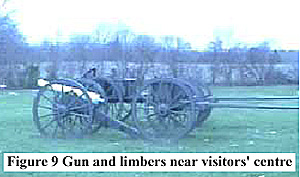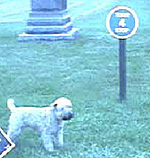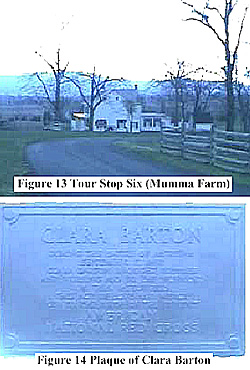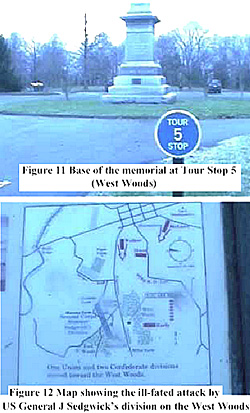 Today is 28 November (Black Friday) and I am going to visit Antietam and Sharpsburg,
Md. The day is aptly named, as it is overcast and wet. The forecast is for more rain and
a drop in temperature.
Today is 28 November (Black Friday) and I am going to visit Antietam and Sharpsburg,
Md. The day is aptly named, as it is overcast and wet. The forecast is for more rain and
a drop in temperature.
The first stop was the visitors’ centre of the Harper’s Ferry National Historical Park to pick up the pamphlet on the town and also directions to Antietam. Then it was on the road to Sharpsburg and into Maryland over the Potomac again.
Sharpsburg is still a small town as it was in 1862, when its population was about 1300. Apart from being the crossing point for the Army of Northern Virginia prior to Antietam and Gettysburg, it was near the town that General Braddock crossed into Virginia to meet with Benjamin Franklin and others in 1755 before Braddock set out on his ill-fated march to Fort Duquesne (now Pittsburgh, Pa.). There is an historical plaque in town commemorating this event.
 The Antietam National Battlefield Park is located north of the town near the road to
Hagerstown. I arrived in time for a very educational lecture on the impact of the battle on
the local population given by one of the park rangers. His 20-25 minute presentation
covered three topics:
The Antietam National Battlefield Park is located north of the town near the road to
Hagerstown. I arrived in time for a very educational lecture on the impact of the battle on
the local population given by one of the park rangers. His 20-25 minute presentation
covered three topics:
- Consumption of food stocks;
- Damage to the farms; and
- Medical and burial services for the killed and wounded.
The two armies basically descended like a horde of locusts and ate just about everything that they could find. Many soldiers, particularly the CS troops, were extremely hungry after days and weeks with minimal rations. The surrounding farms provided an untouched feast, which was quickly consumed. This left the population with little food for the autumn, winter and spring.
 The troops occupied the buildings, helped themselves to the contents, stripped the fences
and woods for their fires, and then battered many with small arms and artillery fire. Only
one building was deliberately destroyed and that was the Mumma family home. It served
as a location from which US troops sniped at the CS artillery near the Dunker Church.
The troops occupied the buildings, helped themselves to the contents, stripped the fences
and woods for their fires, and then battered many with small arms and artillery fire. Only
one building was deliberately destroyed and that was the Mumma family home. It served
as a location from which US troops sniped at the CS artillery near the Dunker Church.
The command was given to burn it down thus depriving the sharpshooters of their cover. After the battle, there were 23,000 casualties and they were either buried (about 5,000) or tended in hospitals established on the former battlefield. Many of the wounded were still there when Lee’s army moved north for the Gettysburg campaign about 10 months later. Following the lecture, I saw the movie about the battle narrated by James Earl Jones. This has a duration of about one hour and is a good overview of the campaign and battle.
I bought a copy along with many books and souvenirs in the bookshop. I toured the rest of the centre and spent about 30 minutes looking at the large paintings by Captain James Hope, who fought in the battle. Following the war, Hope painted large landscape canvases of the main actions of the battle.
The rangers provide several lectures on battlefield topics. One of the most popular is a 30-minute orientation of the battlefield in the observation area inside the visitors’ centre. This is an ideal place for the lecture as it is unaffected by the weather and provides a good view of much of the battlefield.
It was then time for the tour; unfortunately, the weather was getting worse so about half of the time it was raining heavily. Allie and I were able to see most of the area over which the initial fighting took place before the heavy rain. I was able to film the first six tour stops starting at the Dunker Church and ending at the Mumma Farm. At this point, I stayed in my Jeep for the rest of the driving tour, except for a brief stop at the observation tower at the sunken road better known as “Bloody Lane”.
 Fortunately, I had previously visited the park in 1995 so I had plenty of photographs to
supplement the video footage of this tour. I also bought some postcards that were taken
on nice sunny days.
Fortunately, I had previously visited the park in 1995 so I had plenty of photographs to
supplement the video footage of this tour. I also bought some postcards that were taken
on nice sunny days.
I did consider taking a drive over to South Mountain to visit the gaps defended by Lee’s rearguard prior to the battle, but it was too wet and dark. It took me two hours to travel through the park and it was time to seek shelter for the night. I drove to Winchester, where I was able to locate a hotel that allowed pets in the rooms. Allie appreciated the gesture as she had spent the night in Harper’s Ferry in the Jeep.
Of note, Antietam was the first battlefield visited by Clara Barton, who was the first female employee of the US federal civil service. She had raised money with which to buy medical supplies and organised a wagon train to transport her stock from Washington to Antietam. Her arrival was welcomed by the US medical service that had exhausted its supply of bandages early in the battle and had resorted to using cornhusks. Her support thereafter was greatly appreciated and she helped to establish the Red Cross in the US after the war. The war did help to advance medical services as the doctors, nurses and their support staff introduced many new innovations while treating the hundreds of thousands of casualties. It was probably one of the few benefits derived from the war.
The bookstore offers a special package. Anyone who buys an annual park pass also gets an annual National Park pass ($50) and a 10% discount in the bookstore and for other bookstores located on park grounds. I shall be renewing my pass there next year when my current NP pass expires as I can renew on-line at www.AntietamPartner.com.
Back to Sabretache # 6 Table of Contents
Back to Sabretache List of Issues
Back to MagWeb Master Magazine List
© Copyright 2003 by Terry Gore
This article appears in MagWeb.com (Magazine Web) on the Internet World Wide Web. Other articles from military history and related magazines are available at http://www.magweb.com